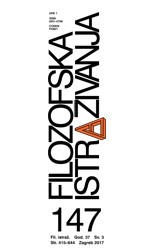Atmosfere i estetski rad: »nova estetika« Gernota Böhmea
Atmospheres and Aesthetic Labour: The “New Aesthetics” of Gernot Böhme
Author(s): Stevan BradićSubject(s): Aesthetics, Phenomenology
Published by: Hrvatsko Filozofsko Društvo
Keywords: atmosphere; senses; distribution of sensible; aesthetic labour; aesthetic economy; new phenomenology; new aesthetics; Gernot Böhme;
Summary/Abstract: This essay is a critical analysis of the “new aesthetics” of contemporary German philosopher Gernot Böhme. Böhme demands an abandonment of classical aesthetics, as a philosophical discipline that solely deals with artistic creation, and its expansion to the entirety of sensory reality. As a starting point he takes the concept of atmosphere, which he introduces through Hermann Schmitz, and by overcoming its dichotomy, uses it to simultaneously explain the process of perception and the construction of sensory reality. The second part of the essay deals with the way in which Böhme applies his insights to the analysis of the late capitalist societies. It is his understanding that atmospheres are produced through aesthetic labour, which shows his awareness of the importance of labour in the production of our common sensory world. The final part of the essay is aimed at the conditions under which aesthetic labour takes place as well as its relation to the “new aesthetics”.This essay is a critical analysis of the “new aesthetics” of contemporary German philosopher Gernot Böhme. Böhme demands an abandonment of classical aesthetics, as a philosophical discipline that solely deals with artistic creation, and its expansion to the entirety of sensory reality. As a starting point he takes the concept of atmosphere, which he introduces through Hermann Schmitz, and by overcoming its dichotomy, uses it to simultaneously explain the process of perception and the construction of sensory reality. The second part of the essay deals with the way in which Böhme applies his insights to the analysis of the late capitalist societies. It is his understanding that atmospheres are produced through aesthetic labour, which shows his awareness of the importance of labour in the production of our common sensory world. The final part of the essay is aimed at the conditions under which aesthetic labour takes place as well as its relation to the “new aesthetics”.
Journal: Filozofska istraživanja
- Issue Year: 37/2017
- Issue No: 03/147
- Page Range: 513-528
- Page Count: 16
- Language: Croatian

